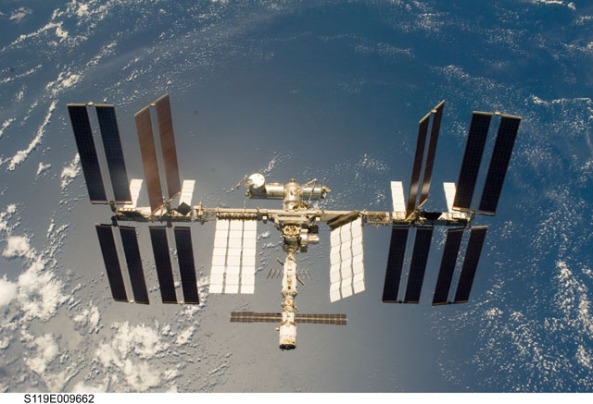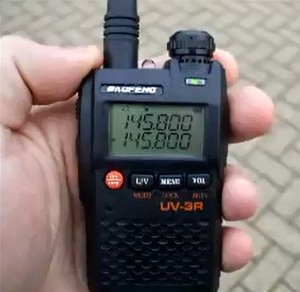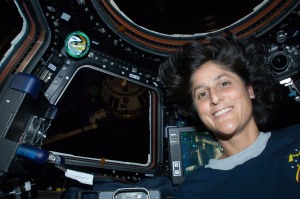The amateur radio station on the ISS can be received using very simple equipment.
History
The first Amateur Radio equipment was delivered to the International Space Station (ISS) in September 2000 and an Amateur Radio station was established onboard for use by Astronauts who are licenced Radio Amateurs. Commander William Shepherd, KD5GS, made the first Amateur contacts in November of that year.
Most of the astronauts on the International Space Station are licenced Radio Amateurs and sometimes during their spare time they talk to other Radio Amateurs back on earth. There is a special thrill in talking to an astronaut out in space!
What equipment do you need to hear the ISS ?
Almost any 144 MHz FM rig will receive the ISS, you can even use a general coverage VHF scanner with an external antenna. As far as the antenna is concerned the simpler the better. A ¼ wave ground plane has a high angle of radiation and works well. Large 144 MHz colinears are not as good because the radiation pattern is concentrated at the horizon while the ISS is above 15 degrees elevation for most of a pass.
You can receive the ISS outdoors using a 144 MHz hand-held with its helical antenna but a 1/4 wave whip will give far better results.
In the UK we use narrow 2.5 kHz deviation FM but the ISS transmits using the wider 5 kHz deviation used in much of the world. Most rigs can be switched been wide and narrow deviation filters so select the wider deviation. Hand-held rigs all seem to have a single wide filter fitted as standard.
Listening Online
If you don’t have an amateur radio receiver you can still listen to the ISS by using an Online Radio, also known as a WebSDR. Select a Frequency of 145800.0 kHz and Mode FM:
• Farnham WebSDR when ISS is in range of London http://farnham-sdr.com/
• R4UAB WebSDR when ISS is over Russia http://websdr.r4uab.ru/
Check the N2YO site to see when the ISS is in range https://n2yo.com/?s=25544&df=1
What will you hear ?
Much of the time the Space Station equipment operates in “automatic mode”. It can act as an AX.25 APRS Packet Repeater, voice repeater or transmit Slow Scan Television (SSTV) pictures. Voice and SSTV transmissions take place on 145.800 MHz FM, the AX.25 packet may be heard on 145.825 MHz FM. (Note: Packet digipeater is no longer active)
The aim to start with is simply to listen to the sounds from the satellite. You can check the current mode of operation on the AMSAT Satellite Status page.
The ISS amateur radio station is used for school contacts. These educational contacts enable students to communicate directly via Amateur Radio with the Astronauts and ask them questions. In recent years a number of UK schools have made contact with the space station thanks to volunteers from AMSAT-UK.
When the astronauts put out a CQ call they also use 145.800 MHz FM but operate “split” listening for replies 600 kHz lower on 145.200 MHz. If you are lucky and hear them calling CQ just remember to activate your rigs repeater shift to ensure you reply on the correct frequency. You should never transmit on 145.800 MHz.
When to listen
The ISS is in a very low orbit and so is only in range 5 or 6 times each day and then only for a maximum of 10 minutes on the best orbit. This means you need to make sure you’re listening at the right time to hear it. There are a number of websites that tell you when to listen such as the N2YO site.
Doppler Shift
The International Space Station is traveling around the Earth at over 28,000 km/h. This high speed makes radio signals appear to shift in frequency, a phenomenon called Doppler Shift.
This Doppler shift will cause the ISS transmit frequency of 145.800 MHz to look as if it is 3.5 kHz higher in frequency, 145.8035, when ISS is approaching your location. During the 10 minute pass the frequency will move lower shifting a total of 7 kHz down to 145.7965 as the ISS goes out of range. To get maximum signal you ideally need a radio that tunes in 1 kHz or smaller steps to follow the shift but in practice acceptable results are obtained with the radio left on 145.800 MHz.
AMSAT-UK
The Amateur Satellite organisation in this country is AMSAT-UK. Its members are involved in the construction of new Amateur Radio satellites and in running the stations used for ISS school contacts and. The group produce a quarterly publication OSCAR News that is full of information on the Amateur satellites. You can join online via the AMSAT-UK website.
Satellite Tracking https://amsat-uk.org/beginners/satellite-tracking/
N2YO tracking site (click Draw Footprint) https://n2yo.com/?s=25544&df=1
You can use online radios to receive signals from the International Space Station:
• Listen to the ISS when it is in range of London with the SUWS WebSDR http://farnham-sdr.com/
• Listen to the ISS when it is over Russia with the R4UAB WebSDR http://websdr.r4uab.ru/
Receiving ISS Slow Scan Television https://amsat-uk.org/beginners/iss-sstv/
How to work the ISS on APRS Packet Radio https://amsat-uk.org/beginners/how-to-work-the-iss-on-aprs-packet-radio/
The IZ8BLY Vox Recoder enables you to record the ISS on 145.800 MHz FM while you’re away from home http://antoninoporcino.xoom.it/VoxRecorder/
Amateur Radio on the International Space Station (ARISS) http://www.rac.ca/ariss/oindex.htm
John Heath G7HIA’s article ‘Getting started on amateur radio satellites’ can be downloaded from https://amsat-uk.org/beginners/radcom-getting-started-on-satellites/





You must be logged in to post a comment.